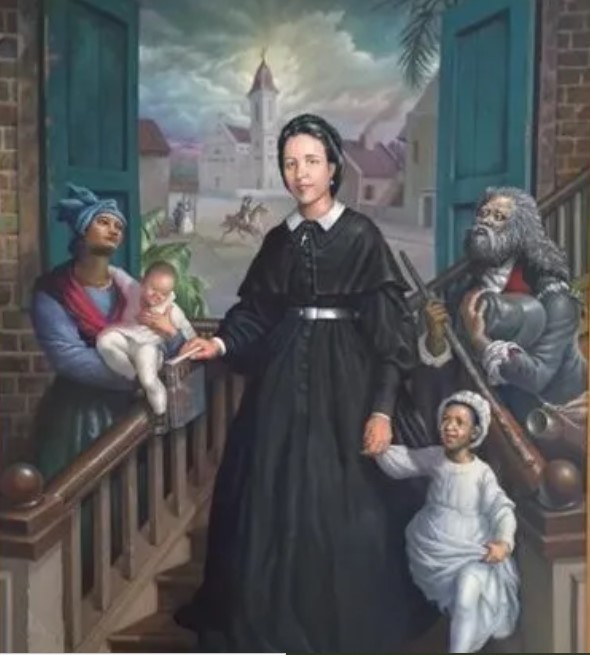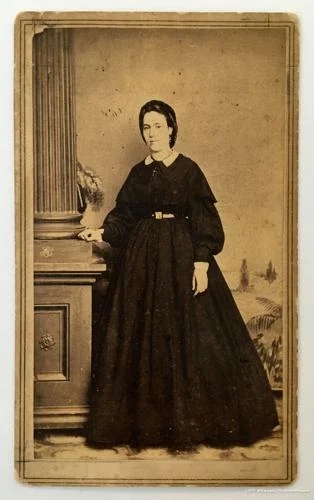In the traditional Catholic French Creole ways of pre-civil New Orleans, most young women did as their mothers taught them. The expectations were clear. Look your very best and find a suitable husband. But not Henriette Diaz DeLille. Henriette was born in 1813. She was considered an octaroon, her mother was a quadroon, which is a French Creole word meaning ¼ African American, ¾ white. Women of color within Henriette’s family can be traced back to her maternal great-grandmother the daughter of Claude Villars Dubruil, born in 1716 who immigrated from France to Louisiana. The family settled in the French Quarter, not far from St. Louis cathedral. Her father Jean-Baptiste Lille Sarpy a married French merchant was also wed in common law to Marie-Josephe “Pouponne” Diaz, a free woman of color from New Orleans. Henriette’s great-great grandmother had been a slave from West Africa.
But that is not what made Henriette special. It was her calling to the religious vocation to serve others. Henriette was schooled in French literature, music, dancing, and even crude nursing skills, which included preparation of medications from herbs. The expectation was that like her mother, Henriette would become a finer lady of the placage system. This meant a common law marriage with a wealthy man, often whom had a white Catholic family of society somewhere else Many women of the quarter were supported financially in elegance in this manner. A “kept” woman so to speak. Dutiful, Henriette attended many of the quadroon balls held in the quarter. She caught many a man’s eye. But Henriette would have none of that, much to her mother’s displeasure.
Delille was an outspoken opponent of the placage system, believing it to be in violation of the covenant sacrament of Catholic marriage. Henriette was a devout Catholic and held strong to her beliefs. She received the sacrament of confirmation from the Catholic church in 1834. Funeral records from the church document that Henriette, during the 1920 as a young teen may have given birth to two sons out of wedlock who died in infancy. In 1835, Henriette’s mother had a psychotic breakdown and was declared incompetent. The court granted Henriette control of her mother’s financials. After providing her care until her death, DeLille sold all of the remaining assets using the funds to found a small group of nuns she called Sister of the Presentation. Their purpose was to care for the sick, help the poor of the quarter and instruct free and enslaved children and adults teaching them how to read and write. She is attributed with establishing the oldest Catholic home for the elderly in America. Many of whom from the Quarter, persons of color and had nowhere to go.
What was remarkable, is that in a male dominated Southern society of culture, Henriette rose above. She used her wit, intelligence and faith to make the impossible possible. She was told “no” on numerous occasions, for example when she applied to the Diocese of New Orleans to have her order of nuns recognized and was denied because they were women of color. At that time, Black women were not seen in the South as worthy of religious life, nor the official habit worn. But she didn’t care, her nuns wore their own self-designed habits and took non-public vows. Henriette continued to fight on with her servitude to others. The order’s legal advisor Etienne Rousselon obtained approval from the order from the Vatican, the Holy See in 1837 establishing Henriette as the mother superior. She took the official religious name of Sister Mary Theresa, however all who knew her called her Mother Henriette.
The order continued their work throughout the poor neighborhoods of post-civil war New Orleans. They cared for literally hundreds of indigent and orphaned children and elderly. In 1842, the order’s name was officially changed to the Sisters of the Holy Family. New Orleans was hit hard by yellow fever epidemics that killed hundreds in 1853. The nuns of Henriette’s order nursed plenty of victims. In November of 1862, Henriette died at age 49. Many saying her death was attributed to never ending life of poverty and hard work. Beginning with only eight original members, by 1909 her order of nuns how now grown to 150 members carrying out her legacy. They now operated parochial schools for children of color. In today’s time, with over 500 members, the order operates free schools for children and nursing homes in New Orleans and Shreveport, LA; Washington D.C.; Galveston, Texas; Little Rock, AR, as well as California and even a mission in Belize.
Recognizing her gift of servitude to the underserved in society within the city of New Orleans named a street after her in 2011. Archbishop Gregory Aymond, still in service to this day, developed the diocesan prayer said by every church each Sunday in New Orleans which prays for an end to violence and racism. The Prayer for the Archdiocese of New Orleans ends with the intercessory not only to our Lady of Prompt Succor, but to Mother Henriette Delille. Mother Henriette was declared by Pope Benedict the XVI to be venerable, now in Step 2 of the canonization process by the Vatican to be named a saint. For her love of the poor and underserved, her lifelong service as a nun and nurse, AgeView press proudly includes Mother Henriette Delille as Belle of Steel #18.

Photo of portrait that hangs in the parlor of the Motherhouse of the Sisters of the Holy Family. Artist of the original portrait was Ulrick Jean-Pierre. Photo credit: Laine Kaplan-Levenson from WWNO.

You must be logged in to post a comment.